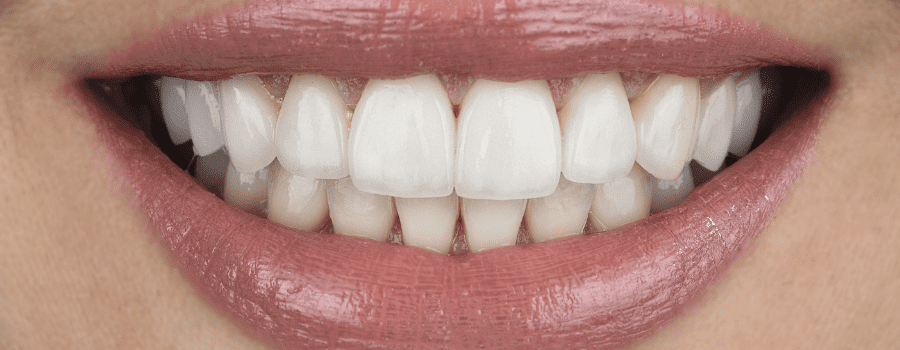Teeth bonding and veneers are both effective ways of improving the appearance of the teeth following damage to the natural teeth. Tooth damage can have a variety of causes, with two of the most common being oral disease or an acute injury. While both teeth bonding and veneers are great solutions for teeth damage, each is best suited for particular situations. To learn more about the specifics of each of these treatments and the pros and cons of each, keep on reading!
Teeth bonding refers to the use of a composite bonding material to fix chips and cracks in teeth that have been damaged. On the other hand, Veneers are better suited for improving the appearance of multiple teeth– typically the entire mouth or the bottom or top set of teeth in their entirety.
In terms of durability, teeth bonding actually wins out in the composite bonding vs veneers debate. It depends in part on the exact material that is used in both the bonding and the veneers; bonded teeth tend to be able to withstand a bit more than the average set of veneers.
As far as appearance goes, veneers have more potential to alter the entire look of your smile. Since veneers can also cover up gaps between teeth or misalignments in addition to damaged teeth, they can offer patients more for improving appearance than teeth bonding. Diastema teeth problems are a great example of what veneers can treat. Teeth bonding can repair minor damage to individual teeth, but it cannot do much to cover up more extensive issues.
Both teeth bonding and veneers are treatments that require regular care and cleaning. With bonded teeth, the care and cleaning are similar to what is typically expected in a quality dental hygiene routine- regular flossing, brushing, and dental visits. Veneers also require this, with the additional step of ensuring that the veneers themselves stay clean and free of trapped debris- especially with removable veneers.
Teeth bonding is likely to be significantly more comfortable than veneers simply because it is altering less of the structure within the mouth. Adding a small amount of composite material to one, or even a couple of teeth, wouldn’t do much to alter the feeling of the existing teeth in the mouth. But how do veneers work? They usually require more drastic changes to the entire tooth’s structure, which may lead to decreased comfort.
Looking at a pros and cons list can allow you to understand the differences between dental bonding vs veneers more clearly. Understanding these differences can, in turn, allow you to make a more educated decision about which of these treatments would be the best option.
Ability to select the precise shade of your teeth.
Removable.
Generally uncomfortable, that’s why it’s key to get the best teeth veneers as they are often more comfortable.
A quick way to fix minor damage to the teeth.
Easy maintenance.
Difficult to cover up more extensive damage.
The cost of teeth bonding depends on several factors. Your location and the provider you choose to go to can have particularly significant impacts on the cost. The complexity of your individual case and the extent to which your provider will have to repair the teeth in question will also have an impact on the final cost. As expected, more damage to the teeth will require more extensive treatment and a higher cost. On average, you can expect to pay around $450 per tooth for teeth bonding vs veneers cost, which tends to run higher.
How much do veneers cost? Similar to the variation in the cost of teeth bonding, not all veneers will cost the same. With veneers, you also have the additional factor of veneer type when determining the final price. Porcelain veneers tend to be the most expensive option, with other types of veneers being a bit more affordable. Since teeth bonding typically uses a composite material, composite veneers are a good point for comparison. On average, composite veneers cost $875, making them a more expensive choice in the teeth bonding vs veneers comparison.
Both teeth bonding and veneers offer reliable solutions for damaged teeth. To determine which of these treatments is the best option for you, you should begin by visiting a trusted dentist or orthodontist for their assessment of the extent of dental damage you have–wondering whether an orthodontist vs dentist would make the most sense to visit? It all depends on what the experience of the practitioner is and what they are licensed in. Be sure to find out this information before deciding where to get your treatment. This information can serve as a good starting point for determining either teeth bonding or veneers, as more extensive damage typically means that you would be a better candidate for veneers. Next, you should start to think about the cost of your treatment options– you should look more into “cost dental bonding vs veneers.” Think about what your budget will look like, as this will have an impact on which treatments are the most realistic options for you. This will likely have the most significant impact if you choose to go with veneers for your treatment since some materials- like porcelain- are significantly more expensive than others.
Other factors that you should also take into consideration are the level of comfort you are looking for and how much you care about being able to whiten or select the shade of your teeth. Teeth bonding vs veneers pictures can also offer more insight into what the two treatments look like and help you come to a final decision on what is best for you.

